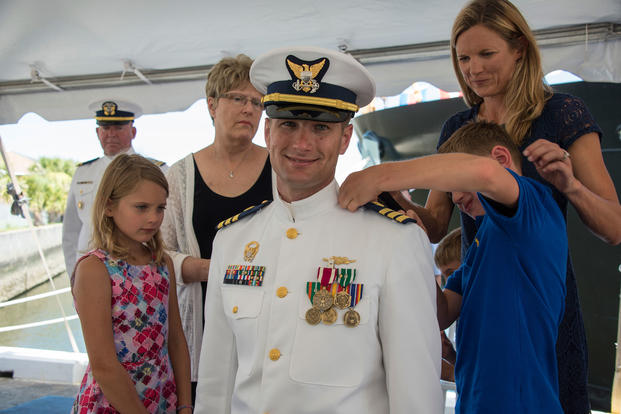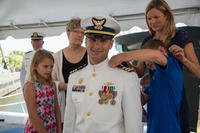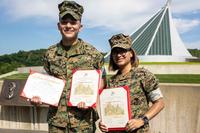Unlike the other U.S. military services, which organize service members according to ranks, the Coast Guard, like the Navy, organizes its enlisted force by paygrades (E-1 through E-9) together with job specialties known as ratings. The combination of rating (job specialty) plus grade (paygrade) is referred to as a rate.
Like the other branches, the Coast Guard uses E-1 to E-9 paygrade structures. The rate and grade of an enlisted Guardsman can be identified by rating insignia (specialty emblem and chevrons worn on enlisted uniforms) that indicate both the rating and the paygrade.
Enlisted Coast Guard rates are broken down into various levels:
- Non-rate or apprentice ranks (E-1 through E-3)
- Petty officer ranks (E-4 through E-6)
- Chief petty officer ranks (E-7 through E-9)
- Master chief petty officer of the Coast Guard (MCPOCG), the senior enlisted member of the service
It should be noted that the Coast Guard is planning a radical redesign, known as "Force Design 2028," which is slated to add more personnel, improved technology and acquisition systems, and changes to its organization that include a service secretary.
In May 2025, Homeland Security Secretary Kristi Noem also announced that the Coast Guard was to cut one-quarter of its 46 flag officer positions by the end of the year.
But for now, here is the structure of the Coast Guard’s enlisted and officer ranks.
Enlisted Coast Guard Rates
The Coast Guard’s Enlisted Careers/Ratings listing on gocoastguard.com shows job specialties (ratings) such as boatswain’s mate, machinist’s mate, electrician’s mate, etc.
Non-Rated Members (Apprentices E-1 through E-3)
The enlisted paygrades E-1 through E-3 in the Coast Guard commonly are referred to as non-rated. This indicates they have not yet completed the resident “A” School or an equivalent training/qualification in a rating.
Once Coast Guardsmen complete "A" School or a Striker program, they are given additional designators, reflecting their new rating. Some E-2s or E-3s may be assigned a designation while pending qualification or time-in-service requirements for a full rating.
At boot camp, new members may receive general designators indicating eligibility for future ratings.
Coast Guard non-rated designators include:
- Seaman -- Deck and Administrative Ratings
- E-2 -- Seaman apprentice (SA)
- E-3 -- Seaman (SN)
- Fireman -- Naval Engineering Ratings
- E-2 -- Fireman apprentice (FA)
- E-3 -- Fireman (FN)
- Airman -- Aviation Ratings
- E-2 -- Airman apprentice (AA)
- E-3 -- Airman (AN)
Being a Coast Guard non-rate is the first step in becoming an integral part of service. As non-rate, the job will be to apply skills and knowledge learned in basic training, begin career training and continue developing followership skills.
Members may advance to E-2 upon completion of basic training.
Whether an AN, SN or FN non-rated Coast Guardsman, the level of expectations increases with each promotion. An E-3’s job is to apply the skills and knowledge learned while continuing to develop their technical and leadership skills. Seamen (SN) may be expected to assume increased responsibility and leadership tasks appropriate to their position.
Seaman Recruit (E-1)
Seaman recruit (SR) is the lowest enlisted rank in the U.S. Coast Guard, just below seaman apprentice. Coast Guard seaman recruits currently do not normally bear any uniform rank insignia, unless they have been reduced in rank for disciplinary reasons.
Seaman Apprentice (E-2)

The title for an E-2 in the U.S. Coast Guard is seaman apprentice, with variations in rating titles based on the specific job specialty.
Those in the general deck and administrative community are seamen apprentice. They wear white stripes on blue uniforms. Those in the engineering and hull community are called firemen apprentice and wear red stripes on a blue background. Those in the aviation community are called airmen apprentice and wear green stripes on both navy blue and white uniforms.
Seaman (E-3)

The title for an E-3 in the U.S. Coast Guard is seaman, with variations in rating titles based on the specific job specialty.
The duties performed by seamen include ship maintenance; equipment maintenance, repair and storage for underway operations; lookout and helmsman duties; serving as a member of damage control, emergency and security alert teams; participating in naval ceremonies; and working with qualified personnel to gain job training and experience. An SN who shows exceptional leadership qualities – or by virtue of their time in service – may be assigned the role and duties of a leading seaman. The leading seaman is often in charge of work parties of two or more other non-rated members.
Moving up in rate: Advancement to E-3 requires completion of certain qualifications and time in service, and it is subject to command approval. An official Coast Guard Recruit Training Pocket Guide outlines the expectations and responsibilities for recruits, including information on rank progression.
Petty Officers (E-4 through E-6)
Coast Guard petty officers are the technical workforce of the service. The grades of petty officer third class through first class indicate a growing level of technical ability, responsibility and leadership.
A petty officer is responsible for their subordinates, which means they are responsible for their subordinates’ well-being, work performance, professional development and more.
Petty officers often are referred to by their grade or their rate and grade. For example, an E-5 avionics electrical technician can be referred to by their grade as Petty Officer 2nd Class Smith (PO2 Smith) or by rating and grade as Avionics Electrical Technician 2nd Class Smith (AET2 Smith).
Enlisted promotions (known as advancements in the Navy and Coast Guard) to the grades of petty officer third class (E-4) through master chief petty officer (E-9) are based on competition for a limited number of vacancies.
Coast Guard petty officers (E-4 through E-6) wear a collar device that features the Coast Guard shield and chevrons corresponding to their paygrade.
Petty Officer Third Class (E-4)

Advancement to petty officer third class (E-4) signifies a transition from a non-rated member to a rated member, with increased responsibilities.
Pinning on the Crow: Unlike advancement to E-2 and E-3, advancement to petty officer is based on basic eligibility requirements and, in some cases, a Coast Guard-wide competition. Basic eligibility for advancement to PO3 is based on the commanding officer's recommendation, at least six months' time in rate (TIR), completion of either "A" school or a formal Striker on-the-job training (OJT) program and nonresident courses.
Note: Coast Guard non-rates who attend “A” school do not participate in the service-wide exam for advancement to petty officer third class. It is earned upon graduation from training.
Petty Officer Second Class (E-5)

Like each grade before it and those that follow, the job of the petty officer second class (PO2) is not much different, but the expectations in technical expertise and leadership abilities are greatly increased. A petty officer second class' level of authority does not increase substantially, but the number of resources – equipment, work groups and watch sections – increases with advancement.
Advancing in grade: Advancement to petty officer second class (E-5) is based on basic eligibility requirements and a Coast Guard-wide competition. The competition is based on your final multiple score (FMS), which includes points for exam scores, personal awards, time in service, time in grade, sea duty and performance.
Petty Officer First Class (E-6)

Petty officer first class (PO1) is the rank where the "rubber meets the road;" it marks a transition process from junior to senior petty officer and a time for transition and training to become a chief petty officer. The petty officer first class' level of authority is usually much greater than the PO2; some PO1s may have the opportunity to become an executive petty officer or even an officer in charge of a small unit of their own. At a minimum, a PO1 is expected to apply their experience and judgment to manage a greater number of resources and personnel than at their previous paygrades.
Pinning on First Class: The basic eligibility requirements for advancement to PO1 include the commanding officer's recommendation, having at least 12 months of TIR and completion of the rating particular qualification requirements. Like the other petty officer promotions, advancement to PO1 is based on the candidate's placement on the Coast Guard service-wide competition and subsequent service-wide examination (SWE) advancement list.
“Advance-to-Position (A2P)” beta test: As of 2023, qualified E6-E9 members can now accept certain positions in return for advancement, as a late or out-of-cycle fill of vacancies. The Coast Guard announced that while this applied to the boatswain’s mate (BM) and electronics technician (ET) ratings, the program was being expanded to include all ratings.
“This change allows qualified E6-E9 members an opportunity to fill vacant positions late in the assignment year (AY) or to fill offseason critical positions in return for advancement to the next higher paygrade,” according to the Coast Guard.
Chief Petty Officers (E-7 through E-9)
Coast Guard chiefs, senior chiefs and master chiefs (E-7, E-8 and E-9) are held in high esteem and to a higher standard than enlisted Coast Guardsmen of lesser paygrades. The Coast Guard Chief Petty Officer's Creed details the leadership qualities to which each chief is held, but more importantly, the creed describes a form of leadership that is grounded in serving others before self.
A Coast Guard chief is expected to exemplify the service’s core values of:
Honor – Integrity is our standard. We demonstrate uncompromising ethical conduct and moral behavior in all of our personal actions. We are loyal and accountable to the public trust.
Respect – We value our diverse workforce. We treat each other with fairness, dignity and compassion. We encourage individual opportunity and growth. We encourage creativity through empowerment. We work as a team.
Devotion to duty – We are professionals, military and civilian, who seek responsibility, accept accountability and are committed to the successful achievement of our organizational goals. We exist to serve. We serve with pride.
Each unit's performance is a direct reflection of its chief petty officers. The chief’s professionalism, performance and hard work are reflected in the unit’s morale, performance and professionalism.
Coast Guard chief petty officers (E-7 through E-9) wear a collar device featuring a fouled anchor and shield, distinct from the Navy's CPO insignia.
Chief Petty Officer (E-7)

Coast Guard chief petty officers are accountable for leading Coast Guardsmen and applying their own experience and skills to enable mission accomplishment while exemplifying the Coast Guard’s core values. In addition, CPOs are responsible for developing enlisted and junior officers.
Depending on the rating or technical expertise, CPOs can hold positions of higher leadership and special assignments, which include career development adviser, executive officer and officer in charge.
Earning the CPO Anchor: Advancement to chief petty officer (E-7) requires the commanding officer's recommendation, at least two years of time in rate (TIR), and completion of rating-specific qualifications and nonresident courses.
Senior Chief Petty Officer (E-8)

Senior chief petty officers (SCPO) are the senior technical supervisors within a Coast Guard rating. SCPOs are primarily responsible for supervising and training enlisted personnel oriented to system and subsystem maintenance, repair and operation rather than individual unit work. Based on wide-ranging experience and specialized training, SCPOs provide the command with a higher level of technical and managerial expertise than is expected at the chief petty officer level.
SCPOs can hold positions of leadership, which include executive officer, command enlisted adviser and officer in charge.
Putting a Star on the Anchor: Advancement to senior chief petty officer (E-8) requires the commanding officer's recommendation, at least two years of TIR as a CPO, and completion of the Chief Petty Officer Academy or a Department of Defense senior enlisted academy.
Master Chief Petty Officer (E-9)

Master chief petty officers are the senior enlisted petty officers in the U.S. Coast Guard. As such, MCPOs are vested with special command trust and confidence, extending to administrative and managerial functions involving enlisted personnel. Each Coast Guard enlisted rating has a force manager called the force master chief. Their role is to provide insight and planning on issues that impact the overall rating.
MCPOs often are assigned as command master chiefs, which means they serve as the senior enlisted adviser in setting command policies concerning the morale, use and training of all enlisted personnel. Depending on where they are assigned, CMCs work directly for their commanding officers or district admirals.
Depending on their rating, assignment history and experience, Coast Guard master chiefs may have their own command as an officer in charge, either afloat or ashore. In addition, they may serve as executive officers or a variety of other high-level positions.
Reaching for the Top – Making Master Chief: Advancement to master chief petty officer (E-9) is based on basic eligibility requirements and the Master Chief Petty Officer service-wide competition.
Basic eligibility for advancement to MCPO includes the commanding officer's recommendation, two years of TIR as a SCPO and completion of the Coast Guard Chief’s Academy or one of the Defense Department's senior enlisted academies.
Information on the advancement processes for chief, senior chief and master chief petty officers can be found on the U.S. Coast Guard Personnel Service Center's Advancement page.
Master Chief Petty Officer of the Coast Guard

The master chief petty officer of the Coast Guard (MCPOCG) is the service’s most senior enlisted member, equivalent to the sergeant major of the Army, chief master sergeant of the Air Force, sergeant major of the Marine Corps, master chief petty officer of the Navy and senior enlisted adviser to the chairman of the Joint Chiefs of Staff.
The person in this position serves as a spokesperson to address the issues of enlisted personnel to the highest positions in the service. As such, he is the senior enlisted adviser to the commandant. The duties of this position vary, depending on the commandant.
“The master chief petty officer of the Coast Guard is selected from a pool of applicants, but selection is heavily influenced by the commandant, who relies on the MCPOCG as a trusted adviser on personnel issues,” Military.com reported in July 2025, when Phillip Waldron was named the service’s 15th master chief petty officer of the Coast Guard. “The position has been a four-year post since the early 1980s, but the changeover usually coincides with the change of command of the Coast Guard commandant.”
Responsibilities of the MCPOCG include advising the Commandant on matters concerning the morale and welfare of active-duty, reserve and retired enlisted members and their families.
“The MCPOCG must be a living example of the Coast Guard’s core values of honor, respect, and devotion to duty,” the Coast Guard says. “Individuals who are selected to serve in this prestigious position must possess the highest standards of professionalism and personal integrity.”
Coast Guard Warrant Officer Ranks

Warrant officers (CWO2–CWO4) are highly skilled specialists promoted from the senior enlisted ranks. They are technical leaders who sit above enlisted members but below all commissioned officers.
“They hold a unique organizational position and provide comprehensive knowledge and management in a technical specialty, such as marine inspection,” according to the Coast Guard.
In most branches of the U.S. military, the Warrant Officer sequence begins at WO1 (Warrant Officer 1). But the Coast Guard and Navy begin this rank with CWO2. When senior enlisted members are selected for the warrant officer program, they are promoted straight into the grade of Chief Warrant Officer 2 (CWO2).
Coast Guard Officer Ranks
Coast Guard ranks for officers are split into two tiers: officer and admiral.
Commissioned Coast Guard officers do not enlist. They serve indefinitely at the pleasure of the president of the United States. They hold a commission charging them with the duties and responsibilities of their specific rank.
“The officer corps provides leadership and professional development to all hands,” according to the service. “The Coast Guard officer corps is largely involved in duties that provide direct or indirect leadership to day-to-day activities of the deployable, mobile or shore-based forces that execute our missions.”
Coast Guard Officers
Ensign (ENS) (O1)

Ensigns are commissioned after completing Officer Candidate School (OCS) or the U.S. Coast Guard Academy, and obtaining a bachelor's degree.
Lieutenant Junior Grade (LTJG) (O2)

Lieutenant junior grades are typically promoted after 18 months of service as an ensign, contingent upon performance and available billets.
Lieutenant (LT) (O3)

Lieutenants are responsible for leading divisions and managing personnel, often serving as department heads or in specialized roles.
Lieutenant Commander (LCDR) (O4)

Lieutenant commanders serve in leadership positions such as executive officers or department heads, often overseeing operational and administrative functions.
Commander (CDR) (O5)

Commanders often serve as commanding officers of units, including ships, air stations or shore commands, and may also hold senior staff positions.
Captain (CAPT) (O6)

Captains hold significant leadership roles, often commanding large units or serving in senior staff positions, and are expected to demonstrate exceptional leadership and management skills.
Coast Guard Admirals
Rear Admiral Lower Half (RDML) (O7)

Rear admiral lower halves mark the beginning of the flag officers (O7 to O10) level in the Coast Guard. RDMLs typically serve as commanders of Coast Guard districts, which oversee operations across multiple states and extensive maritime areas.
Rear Admiral (RADM) (O8)

Rear admirals command large operational areas, including multiple districts, and may oversee significant portions of the Coast Guard's missions.
Vice Admiral (VADM) (O9)

Vice admirals hold the rank of O-9 and are typically assigned to significant national and international operational commands.
Admiral (ADM) (O10)

Admiral is a four-star rank in the Coast Guard, typically held by the commandant, who is the senior officer of the service.
Interested in Joining the Military?
We can put you in touch with recruiters from the different military branches. Learn about the benefits of serving your country, paying for school, military career paths, and more: sign up now and hear from a recruiter near you.
















